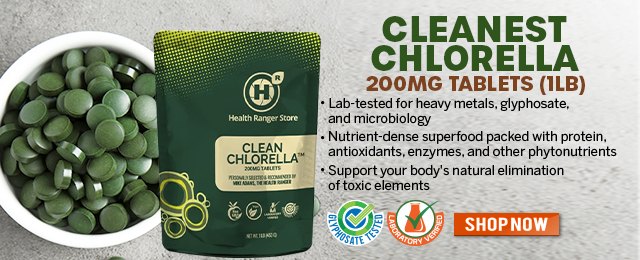Vitamin C protects plants from damaging sun rays
Saturday, January 17, 2015 by: PF Louis
Tags: vitamin C, plant defenses, sunlight

- TAKE IT DOWN Act advances in Congress amid free speech concerns
- Gardening tips: 15 Simple tricks to double your garden’s yield this season
- Survival 101: Dangerous places to avoid when disaster strikes
- Nature’s arsenal: How plant compounds power military survival and healthcare in crisis
- Kawasaki unveils rideable ROBOT HORSE powered by hydrogen
- DOJ and ATF kill Biden’s “Zero Tolerance” firearms dealer policy
- Amazon's Kuiper satellite launch delay highlights uphill battle against Musk's Starlink
- Hospital staffers sound alarm after 10 nurses were diagnosed with BRAIN TUMORS
- Barley: A nutrient-dense ancient grain with modern benefits
- Criminal referral requests filed against Fauci and top COVID officials in seven states
- “Prepare Tribe: Prepare, Protect, Provide” on BrightU: How to build a disaster-proof shelter in the middle of nowhere
- New studies ignite debate: Fluoride linked to autism and ADHD, prompting calls for policy reassessment
- Germany prepares students for war amid growing security concerns
- Rafael Medoff explores the role of Jabotinsky in the rise of Revisionist Zionism in “Militant Zionism in America”
- Sovereign debt paradox: U.S.-China mutual holdings fuel geopolitical tensions
- Yoga and autism: A science-backed look at how a simple practice is transforming behavior and movement in children with ASD
- POLL: U.S. support for Israel drops to lowest level in decades amid Gaza War
- Widespread social and economic unrest: Steve Quayle issues urgent financial warning of imminent asset collapse in new interview with Mike Adams
- Tulsi Gabbard leads charge against the Biden regime’s global censorship of the 'Disinformation Dozen'
- Fauci is back in the limelight, and he’s busy promoting a future COVID or FLU pandemic
- Aerosolized bioweapons? Strange “diploid biomasses” falling out of the sky in Florida captured under the microscope
- Analysis: The coming economic collapse, a mass uprising and Trump's three secret weapons to halt the growing revolt
- Widespread social and economic unrest: Steve Quayle issues urgent financial warning of imminent asset collapse in new interview with Mike Adams
- Kiss Your Genetic Privacy Good-Bye! 23andMe Gets Green Light to Sell Your Intimate Genetic Details to Anyone They Want
- Tulsi Gabbard takes aim at censorship: Justice for the ‘Disinformation Dozen’
- Mike Adams releases country western hit single: Goin’ Back in Time is Comin’ Home
- U.S. lawmakers investigate Meta over alleged China collaboration
- CLOT SHOT PLANDEMIC UNFOLDING: Fibrous, rubbery clots caused by covid injections have prion-like seeding activity
- Chemtrails unveiled: How the CIA and Big Business are manipulating the weather for profit
- How Israeli military-connected corporations are secretly controlling your online privacy
- European Court of Justice: Healthcare professionals who promoted or administered COVID-19 vaccines are CRIMINALLY LIABLE for any harm caused
- DEATH by VACCINE or face PRISON time: Canadian Freedom Convoy leaders CONVICTED for protesting forced vaccination during the Covid Plandemic
- Defunding DEADLY mRNA jabs: Government funding for mRNA technology being scrutinized and sidelined until proven "safe and effective" for real
- Federal employees whine over DOGE's new directive requiring them to do a 5-point summary of weekly accomplishments
- U.S. approves new Russian ambassador as diplomatic thaw continues
- Curcumin’s ancient healing power supercharges muscle recovery, and its effects are compounded with anti-inflammatory foods and supplements
- Newly released JFK files reveal Pentagon's role in creating Lyme disease and covid in the same lab
- Analysis: The coming economic collapse, a mass uprising and Trump's three secret weapons to halt the growing revolt
- Mike Adams releases country western hit single: Goin’ Back in Time is Comin’ Home
- Aerosolized bioweapons? Strange “diploid biomasses” falling out of the sky in Florida captured under the microscope
- Kiss Your Genetic Privacy Good-Bye! 23andMe Gets Green Light to Sell Your Intimate Genetic Details to Anyone They Want
- Dr. Mike Yeadon releases 15-minute testimony - WATCH - about genocidal intent of COVID “vaccines”
- Trump reverses course on Gaza plan, says “nobody is expelling Palestinians”
- MEDICAL BOMBSHELL: FDA admits Covid mRNA 'Vaccines' CAUSE CANCER
- European Court of Justice: Healthcare professionals who promoted or administered COVID-19 vaccines are CRIMINALLY LIABLE for any harm caused
- The Health Ranger releases “Vaccine Zombie” song and music video, using AI-animated zombies for the music video
- 5 Simple steps to boost your brainpower: How to strengthen executive function in a distracted world
- A lack of integrity in Academia: Harvard professor found GUILTY of fraudulent research to promote CRT theory
- Federal employees whine over DOGE's new directive requiring them to do a 5-point summary of weekly accomplishments
- EPA advisor admits the agency is funneling billions to climate groups ahead of Trump’s return to White House
- California's social media censorship law struck down: A victory for free speech or a threat to online safety?
- Space war brewing? Russia threatens to destroy Starlink satellites
- Survival 101: Effective EMF blocking techniques
- Rep. Nancy Mace introduces bill to ban biological males from female facilities on federal property
- Red Cross issues warning to stop blood plasma donations from vaccinated people
- Scientists confirm: GENIUS brain function can be spontaneously unleashed in humans without any apparent cause
- EPA advisor admits the agency is funneling billions to climate groups ahead of Trump’s return to White House
- HYSSOP: What research reveals about the health benefits of this ancient holy herb
- Two containers with completed ballots fall out of truck in Florida
- Newly released JFK files reveal Pentagon's role in creating Lyme disease and covid in the same lab
- Global leaders unite to clamp down on “misinformation” with UN-backed Cascais Declaration
- BREAKING: 2025 NDAA authorizes mandatory military draft of WOMEN across America… as Pentagon pursues global NUCLEAR war with both Russia and China at the same time
- Michael Yon warns of a ZIONIST TAKEOVER in Trump’s second administration
- Ozempic and Wegovy weight loss drugs are injectable LIZARD VENOM PEPTIDES that may unleash a devastating wave of organ failure… side effects align with symptoms of SNAKE BITES
- The Health Ranger releases “Vaccine Zombie” song and music video, using AI-animated zombies for the music video
- Mike Adams releases country western hit single: Goin’ Back in Time is Comin’ Home
- BOMBSHELL: DNA testing kits are a SCAM to develop ethnic-specific bioweapons
- Israeli soldiers accused of even more torture and abuse in the West Bank
- These 13 countries just signed an agreement to engineer a global FAMINE by destroying food supply
- NASA admits that climate change occurs because of changes in Earth’s solar orbit, and NOT because of SUVs and fossil fuels
- Fully vaccinated about to see “tsunami” of illness and death, warns virologist
- RFK Jr. clears key hurdle: Sen. Susan Collins backs controversial HHS nominee, signaling a new era for health policy
Light is part of a process called photosynthesis that plants use to convert CO2 into oxygen. This conversion of light energy into cellular plant food with its oxygen byproduct is the opposite of how it works with animal and human species that feed on plants and use their oxygen byproduct.
Animals and humans have mitochondria that use oxygen to help create the adenosine triphosphate (ATP) that cells need for energy. So the polar similarity of chloroplasts and mitochondria is obvious. Sunlight helps create vitamin C in plants. Most animals create their own vitamin C, but we humans need to obtain our antioxidant vitamin C from plant foods.
Sunlight is the energy source that initiates the plant process of vitamin C production, which we need from plant foods since the gene that most animals have to generate vitamin C is different in humans. Sunlight also initiates the process in our skin to create our important disease-preventing pre-hormone known as vitamin D.
But too much or too little light can disrupt the plant's ability to protect itself against self-generated oxygen free radicals that can create cellular havoc within them, inhibiting plant growth.
Going through the trouble of finding the biochemical mechanics in plants for vitamin C
It's not just the heat from sunlight that plant-generated vitamin C protects them from. The process of creating heat-shock proteins with vitamin C's help to dissipate excess energy from light has been observed even in temperature-controlled rooms.Similar heat-shock proteins occur when there is too little light but herbicides have been applied. Think Roundup, the most commonly used herbicide on the planet.
One study by researchers from the University of California at Berkeley and the Lawrence Berkeley National Laboratory in Berkeley, California, was conducted in 2005 using the plant Arabidopsis, which is the commonly used model system for identifying plant genes and determining their functions.
As reported online by Science, the researchers discovered "that excessive sunlight triggers the formation of zeaxanthin," a carotenoid. The zeaxanthin "molecule transfers an electron to chlorophyll, rendering it incapable of generating reactive oxygen. The positively charged zeaxanthin then combines with the negatively charged chlorophyll in a reaction that disperses away excess energy as heat."
But that was evidently not enough to satisfy a group of researchers at the RIKEN Center for Sustainable Resources and Okayama University in Japan. More recently, in 2014/15, researchers there probed the exact process of what creates a plant's protective process of inhibiting oxidative damage from excess or insufficient light, using the same Arabidopsis plant that is commonly the subject for internal biochemical plant studies.
They isolated and identified PHT4;4 as the transport protein that allows vitamin C as ascorbic acid to enter chloroplasts. They discovered that, when PHT4;4 was removed, the plant was easily adversely affected by excess or insufficient light. Vitamin C is crucial as a coenzyme for developing the zeaxanthin that dissipates excess light as heat, and this protein is only in leaves, not roots.
According to lead author Takaaki Miyaji of Okayama University, "I believe that this research could lead to innovations that target PHT4;4 in order to create crop plants that can more efficiently transport vitamin C into the chloroplast."
Takahashi Kuromori of RIKEN added, "These plants would then have better than normal photoprotective properties and could prevent reduced growth in farmland that suffers from high light exposure."
Look out, Monsanto might be grabbing yet another genetic engineering project to foist on the world.
Sources:
http://www.alphagalileo.org
http://www.biology4kids.com
http://news.sciencemag.org
http://blogs.redorbit.com
Vitamin C at FETCH.news
Get independent news alerts on natural cures, food lab tests, cannabis medicine, science, robotics, drones, privacy and more.
Take Action: Support Natural News by linking to this article from your website
Permalink to this article:
Embed article link: (copy HTML code below):
Reprinting this article:
Non-commercial use OK, cite NaturalNews.com with clickable link.
Follow Natural News on Facebook, Twitter, Google Plus, and Pinterest
Science News & Studies
Medicine News and Information
Food News & Studies
Health News & Studies
Herbs News & Information
Pollution News & Studies
Cancer News & Studies
Climate News & Studies
Survival News & Information
Gear News & Information
News covering technology, stocks, hackers, and more



"Big Tech and mainstream media are constantly trying to silence the independent voices that dare to bring you the truth about toxic food ingredients, dangerous medications and the failed, fraudulent science of the profit-driven medical establishment.
Email is one of the best ways to make sure you stay informed, without the censorship of the tech giants (Google, Apple, Facebook, Twitter, YouTube, etc.). Stay informed and you'll even likely learn information that may help save your own life."
–The Health Ranger, Mike Adams













































